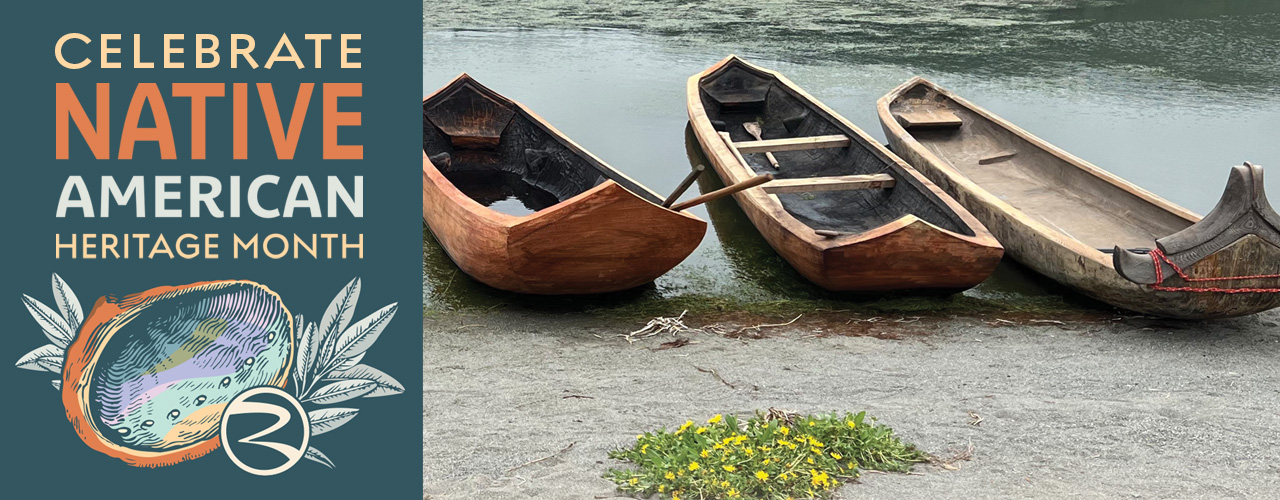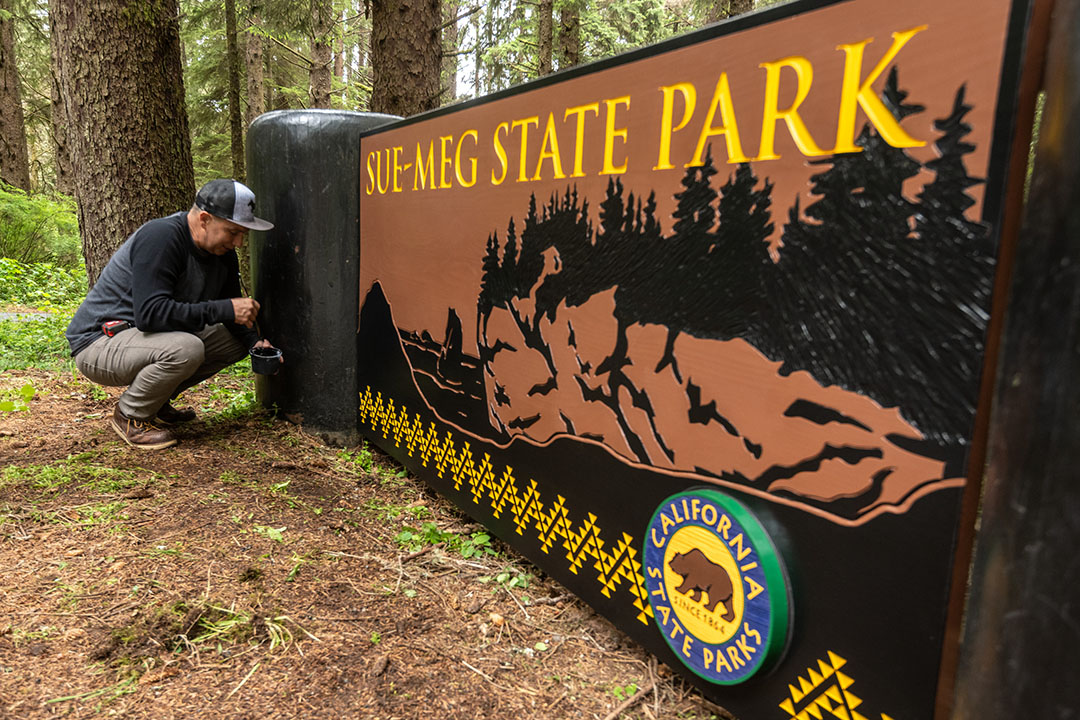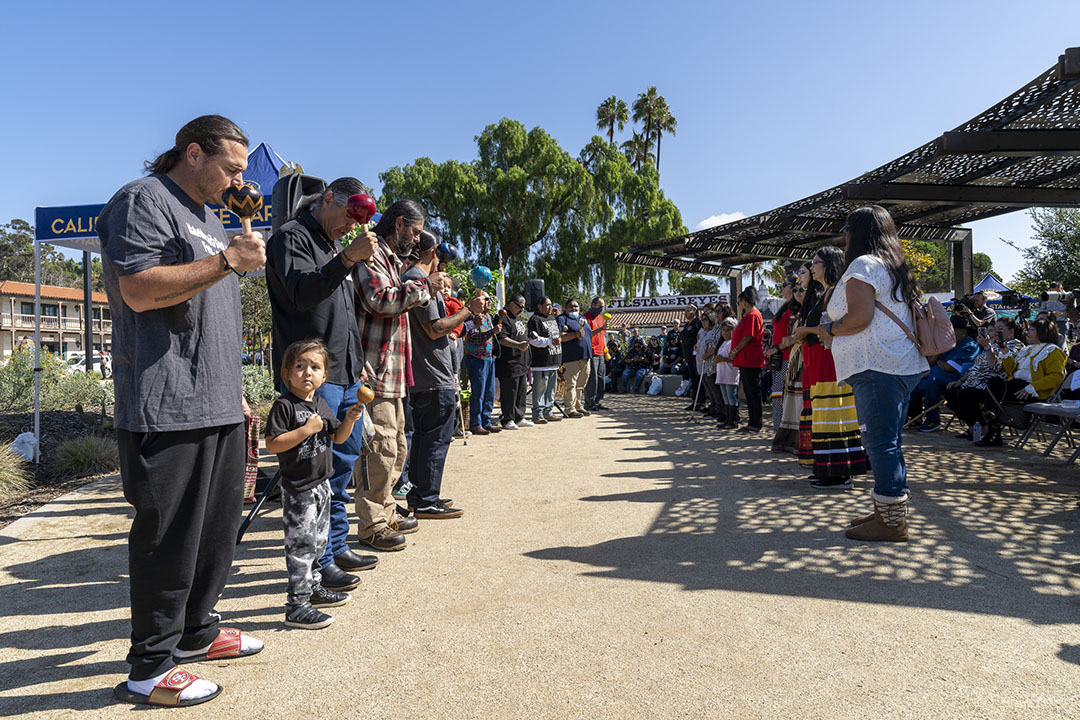Celebrate Native American Heritage Month

November is National Native American Heritage Month, where the original peoples of what is now the United States of America are celebrated. California Native Americans have been caring for the land of California since time immemorial. California State Parks recognizes this legacy as we work together with Tribal partners to preserve and protect California’s natural and cultural heritage for generations to come.
As part of the department’s Reexamining Our Past Initiative, State Parks is actively consulting and working with Tribes to more accurately reflect their history throughout the State Park System.
 Sign Carver Alme Allen, a local artist of Karuk and Yurok descent who was hired to redesign the signs, puts the finishing touches on the new Sue-meg State Park sign June 2022
Sign Carver Alme Allen, a local artist of Karuk and Yurok descent who was hired to redesign the signs, puts the finishing touches on the new Sue-meg State Park sign June 2022
The department continues to work with California Native American tribes and the public to identify and rename features in the State Parks System to honor California Native Americans’ deep connections to these ancient landscapes. In 2023, two park features at Anderson Marsh State Historic Park were renamed. A ridge, formerly known as Lewis Ridge, was renamed Mxqawlay’ba Knowin Xyoykith Ridge, which translates to “the grandmothers/ancestors heal on this mountain,” in Southeastern Pomo. The other park feature that was renamed is the McVicar Trail, now called Dawa Qanoq’ana, which translates into “south way in front of me.”
State Parks works with California Tribal Nations to establish Memoranda of Understanding (MOUs) to create protocols for successful cooperation and partnership. In the past year, State Parks has signed MOUs with the Washoe Tribe of Nevada and California, the San Luis Rey Band of Luiseño Indians, the Cher-Ae Heights Indian Community of the Trinidad Rancheria, the Shingle Springs Band of Miwok Indians, the Bear River Band of the Rohnerville Rancheria, and renewed an MOU with the Koi Nation of Northern California.
 Dancers during the performance of the grand opening of lipay~Tipai Kumeyaay Mut Niihepok (Land of the First People) in 2021 at Old Town San Diego State Historic Park
Dancers during the performance of the grand opening of lipay~Tipai Kumeyaay Mut Niihepok (Land of the First People) in 2021 at Old Town San Diego State Historic Park
California Native American History
Below you will find some state parks that allow you to connect and learn more about California Native American history:
The Antelope Valley Indian Museum (AVIM) interprets the California Indian cultures of the Western Great Basin, East and Southeast of the Sierra Nevada Mountains. This includes the Kitanemuk, Mojave, Halchidhoma, Quechhan, Kawaiisu, Southern Paiutes, California and Arizona Indian tribes.
This park contains 1,185 granite bedrock mortars, which is the largest collection of mortars in North America. Chaw’se Regional Indian Museum features a variety of exhibits and an outstanding collection of Sierra Nevada Indian artifacts, including those from Northern, Central, and Southern Miwok, Maidu, Konkow, Monache, Nisenan, Tubatulabal, Washoe and Foothill Yokut. In the Miwok language, Chaw'se refers to the grinding holes where acorns, seeds, and other items were processed. This park includes a Miwok village complete with a roundhouse, bedrock mortars and petroglyphs.
Ya’l Heki’ Regional Indian Museum includes interpretive exhibits of the Mojave Desert group culture of Serrano, Cahuilla, Cupeño, Gabrieleño, Vanyume, Luiseño and Chemehuevi tribes. The name "Ya'l Heki'" translated from the Cahuilla language means "Home of the Wind." The holdings at Lake Perris includes a small basket collection, pictures and murals of local California Indians.
This park includes Sumeg Yurok Village with traditional style family houses which are currently used by Yuroks for education of their youth and to share their culture. In the Yurok language, Sumeg refers to an ancient ceremonial and important gathering place. Sue-meg State Park on the North Coast of California was primarily Yurok Indian Territory with the Wyiot tribe to the south, Tolowa tribe to the north, and the Karuk and Hoopa tribes to the east. The Yurok Village consists of homes, a sweathouse, changing houses and a dance house. The surrounding archaeological sites have great importance. The village houses an original dugout redwood canoe, which was crafted by the late Yurok canoe maker, Dewey George. This park contains a Native American Plant Garden which has the plants used in medicinal, basketry, subsistence and ceremonial purposes of the Yurok Tribe.
Cultural items include basketry, beadwork, clothing and exhibits about the ongoing traditions of various California Indian tribes; emphasis on Central Valley groups including the Yana, Yokuts Monache, Patwin, Wintu, Maidu, Koncow, Nisenan, Tubatulabal and Nomlaki. There is a special display about “Ishi, Last of the Yahi Indians.” This museum illustrates the theme "A Continuing Culture," the objects are mounted in displays interpreting spiritual activities, objects needed for daily living and examples of excellence in basketry.

 Partner Toolkit
Partner Toolkit